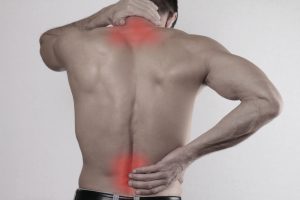
Foto: albina glisic/shutterstock.com
7 easy steps to better posture and possible back-pain relief
Low back pain (LBP) is a very common global health problem that most people experience at some point in their life, particularly between the ages of 35 and 55. The WHO’s 2010 Global Burden of Disease Study estimated that LBP is among the top 10 diseases and injuries that account for activity limitation and work absence, affecting performance in all areas of life and general well-being. Worldwide, the prevalence of chronic, impairing LBP is raising in all age groups and genders. Several risk factors have been identified (such as occupational posture, depressive moods, body height and age), however, the causes of the onset of LBP remain unknown.
While nothing can be done about body height and age, posture can be improved easily with some level of attention and practice. And standing upright and looking the world straight into the eyes does not only reduce the strain on your muscular-skeletal system and thus improve you well-being and energy level, it may even improve your mood!
Here are the 7 steps:
- Feet: stand hip-width* apart, feet pointing straight to the front. Make sure you feel the entire heel and ball of your foot on the floor and you put equal weight on the front and back and outside and inside of the foot.
- Knees: Bend you knees slightly, keeping the legs parallel, that means the knee caps face to the front and the second/third toe.
- Pelvis: imagine there is a weight hanging down the tip of your sacrum (the bone that is fitted between the two hip bones) – that means the tip of your sacrum, as well as your sit-bones are pointing downwards vertically. This slightly lengthens the lower back area, without taking away the natural curve of the spine in the lumbar region.
- Upper back: make sure that your upper back is on top of the pelvis and does not lean back placing it actually behind the pelvis. You need a mirror or – even better – somebody to watch you and direct you in the right direction. Be aware that even a slight correction in your alignment will feel extremely weird at first – until your system adapts to the new arrangement.
- Shoulders: imagine your shoulder girdle – scapula in the back and clavicles in the front. Then slightly lift the shoulder girdle off your rib cage and gently place it back on the ribs like putting something on a table. The shoulders can just rest on the ribs, the arms can dangle down, you do not need to hold them. The frequently heard “shoulders back” is a big misunderstanding, that just gives you tension between the shoulder blades.
- Head and neck: Imagine a little air cushion behind your ears at the base of your skull. By gently inflating the cushion, allow the back of the head to rise slightly upwards, lengthening the neck. This will bring your chin down a bit, so that it can rest parallel to the floor instead of pointing upwards. Be careful – what I see people usually do when trying to lengthen their neck is that they bring the back of the head further back and down instead of up and to the front. That is the exact opposite of what you should be doing! And – the movement of lengthening is tiny, hardly noticeable. Also, with this correction you will usually have the sensation of looking down – which makes sense, since you changed the position of the head without changing the way you look – the eyes need to find a new position so they can look straight to the front again.
- Float and anchor yourself: Using the image of the head being a balloon floating up to the ceiling you can now let your spine dangle down from the head like a pearl necklace – at the bottom end of the spine is then the pelvis with the weight at the sacrum pulling it down. Breathe deeply and relax into those two forces, one pulling you up (the centrifugal force) and one pulling you down (gravity at its best). The more you relax into the floor (or into the chair when sitting), surrendering your weight to the ground while at the same time floating up, making sure that all the parts are stacked vertically on top of each other, the easier it will be for your body to find its proper alignment, reduce postural effort and take out inappropriate strain.
Now that you accomplished to do it once, you need to practice it. The best is to put yourself an anchor – e.g. each time you wait at a red light you upright yourself, or each time you get a phone call, you do it. In the beginning, make sure that you control your alignment, either in a mirror, a shopping window, or asking a real person. Breathe, relax and notice how you grow taller on your way to increased well-being.
*Hip-width means, the feet are below the hip joint (not the outside of your hips): If you place your hands on your hip bones, the finger facing the groin and then bend one leg, lifting it off the floor, you can feel the joint.